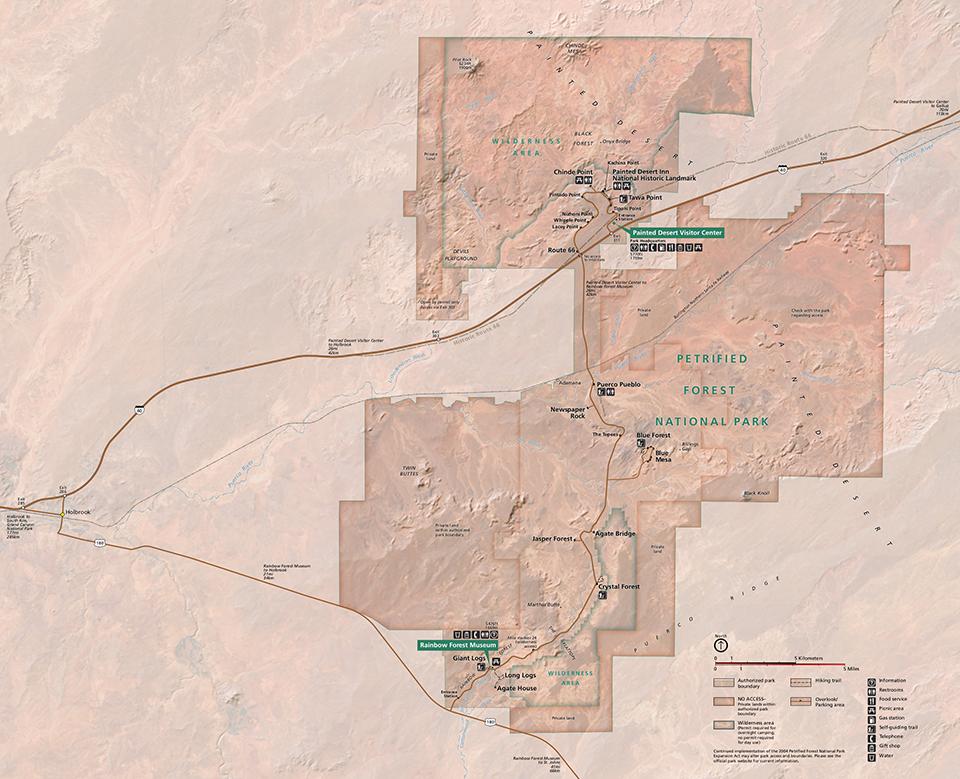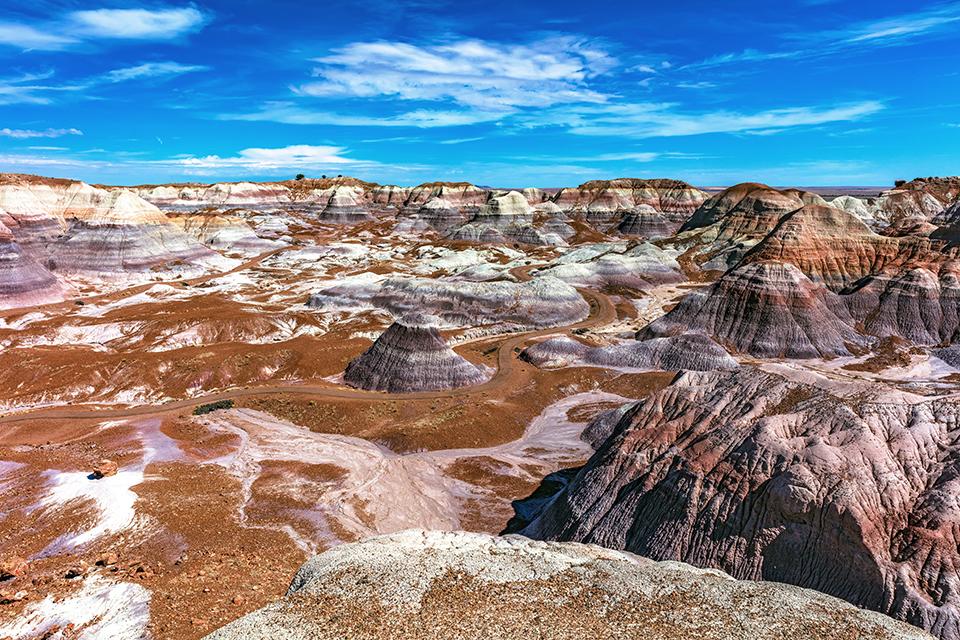
Colorful petrified logs in Petrified Forest National Park / Rebecca Latson
Imagine walking along a trail scattered with sections of silicified logs splashed brilliant shades of red, orange, yellow, white, and purple. Imagine being surrounded by mesas of candy-striped blue, purple, and beige sediment layers. Imagine gazing out upon a red-, orange-, and yellow-painted badlands right next to an interstate highway. This fossil feast of color for the eyes is what you’ll see when you visit Petrified Forest National Park in Arizona, located just off of Interstate 40. The Traveler’s Checklist can help you plan your trip and make the most of your time exploring the park.

Map of Petrified Forest National Park / National Park Service
- The small town of Holbrook, conveniently located between the northern and southern entrances to the park, is the closest source of brick-and-mortar lodging. If it’s camping you are contemplating, then be aware there are no developed campgrounds within Petrified Forest, but there is backcountry camping for which permits are free. Outside the south entrance of the park are two privately-owned gift shops which allow overnight parking for those who are fully self-contained (i.e., you have your own toilet), and there are private campgrounds in and around Holbrook and nearby communities. For more camping information, click here.
- Take plenty of water for your adventures. It’s dry out there, no matter which season you visit.
- This national park has opening and closing hours that differ throughout the year, so check the park website for current times of operation. It is only open during daylight hours to help prevent the theft of petrified wood. Note: Arizona is on Mountain Standard Time year-round and does not observe Daylight Savings Time.
- Upon your arrival, check out the Painted Desert Visitor Center at the park’s north entrance right off of I-40. The Visitor Center is part of the historic Painted Desert Community Complex. There are restrooms, a gift shop, a gas station, public pavilion, and a short loop trail on which to stretch your legs as you learn about points of interest within the park.

The view out across Blue Mesa Trail, Petrified Forest National Park / Rebecca Latson
- Go for a hike. The developed trails are short – the longest is two miles, round trip. The .75-mile Crystal Forest loop trail is a great introduction to petrified wood deposits strewn everywhere you look, and the Blue Mesa 1-mile loop trail allows you to hike among badlands of blue, purple, and white bentonite clays, with chunks of petrified logs scattered here and there. Take the Blue Mesa Trail hike in the morning when the park first opens up. The temperature will be cooler and the sun will be at a nice angle for photography.
- If you are looking for a longer trail on which to stretch your legs, try one of the backcountry hikes. You can ask for the trail routes at the visitor center. Guided backcountry hikes are also offered. Check this link as well as the park’s social media pages (@PetrifiedNPS on Twitter, @PetrifiedForestNPS on Facebook) as you plan your trip to see what is offered during that particular time.
- Bring your horse and go on a horseback ride.
- Drive the park road from start to finish, stopping at all the view areas for different perspectives of the land, from the Blue Mesa badlands, to the colorful striped "Teepees," and all along the Painted Desert for different perspectives (and photographs).
- Tour the almost-100-year-old historic Painted Desert Inn, once a small inn, lunchroom, and souvenir shop and a now national historic landmark and museum.
- Visit the Rainbow Forest Museum near the southern entrance to the park. Take a break to look at the paleontological exhibits and watch the 18-minute orientation film shown continuously throughout the day. From there, you can access the Giant Logs, Long Logs, and Agate House trails.
- Have fun on a real treasure hunt with geocaching in the park. “There are different kinds of caches in the park including virtual, traditional, and Earthcaches. Some of the caches are part of the Find Your Park GeoTour, also.”
- Do some stargazing in the park. Petrified Forest is an International Dark Sky Park. Although the gates are closed from about dusk to about dawn the next day, if you do any backcountry camping, you'll have a wide expanse of starry skies upon which to gaze and photograph.
- Depending upon how long you are staying in the area, take a side trip to Canyon de Chelly National Monument or El Morro National Monument, each of which are approximately two hours’ drive from Petrified Forest National Park.
- Before you go on your trip, remember to check the park’s website to find out if and where pets are allowed, as well as any closures or restrictions due to construction, weather, or Covid-19 that might be in effect.
- As you make your trip plans, remember, the coronavirus pandemic is not over, yet. Per the National Park Service, whose parent organization is the Department of the Interior: “To protect the health of those who live, work, and visit America’s national parks, face masks are required in all NPS buildings and facilities. Masks are also required on NPS-managed lands when physical distancing cannot be maintained, including narrow or busy trails, overlooks, and historic homes.” So, travel safely, take some masks, practice social distancing and wash your hands often.

A painted desert as far as the eye can see, Petrified Forest National Park / Rebecca Latson



Add comment